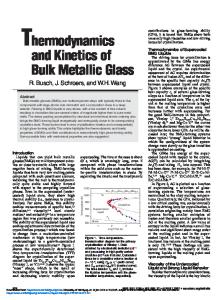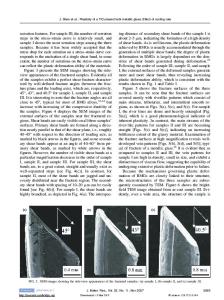Nanoindentation Analysis of Plasticity Evolution during Spherical Microindentation of Bulk Metallic Glass
- PDF / 814,088 Bytes
- 6 Pages / 612 x 792 pts (letter) Page_size
- 106 Downloads / 342 Views
1049-AA05-01
Nanoindentation Analysis of Plasticity Evolution during Spherical Microindentation of Bulk Metallic Glass Byung-Gil Yoo, and Jae-il Jang Division of Materials Science and Engineering, Hanyang University, Seoul, Korea, Republic of ABSTRACT Unlike most of crystalline metals, metallic glasses are known to exhibit a fully-plastic behavior or work softening during mechanical deformation. To analyze the characteristics of the deformed region, here a series of instrumented micro- and nano-indentation experiments were performed on a Zr-based bulk metallic glass (BMG) with geometrically self-similar sharp indenter as well as spherical indenters. First, we performed instrumented micro-indentation tests with a spherical indenter on the bonded interfaces of the BMGs. Although adhesive (used for bonding the interfaces) might significantly affect the deformation mode by reducing the constraint, the evolution of subsurface plasticity during spherical indentation was clearly observed. Subsequently, the subsurface plasticity underneath the hardness impressions was systematically examined through nanoindentation. The results are discussed in terms of major change in mechanical responses of BMGs before and after indentation-induced deformation.
INTRODUCTION It is well known that bulk metallic glasses (BMGs) show unique plastic deformation at low temperature and high stress, i.e., once plasticity is initiated, it is highly localized into narrow shear bands [1-2]. Recently, instrumented indentation technique [3-4] has been widely used for analyzing this interesting phenomenon of BMGs. In particular, a new focus of many indentation works on BMGs is their inhomogeneous plastic flow during indentation experiments [5]. A number of studies have reported reproducible ‘serrations’ in nanoindentation P-h curve and now it is well accepted that the serrations are associated with shear bands nucleation and/or propagation [6-10]. Nevertheless, there have been difficulties in assessing practical shear banding phenomena during indentation, simply because the shear bands are often captured beneath the indenter and cannot expand to a free surface [11]. To overcome the difficulties, ‘interface bonding technique’ has been extensively applied to explore the subsurface deformation of BMGs underneath the indentation impression [12-17]. However, previous studies have been mostly limited to the analysis of the subsurface deformation induced by Vickers indentation at different loads [12-14,16-17] or by spherical indentation at a specific given load [15]. Unlike indentation with a geometrically self-similar sharp indenter, indentation with a spherical indenter produces increase in representative stress and strain as the applied load is increased. Therefore, by analyzing the subsurface morphology of spherical indentation made at various loads, one might gain somewhat new insights on the inhomogeneous plastic deformation of BMGs. With this in mind, here we examined the evolution of plastic deformation in a Zr-based BMG during spherical indentation
Data Loading...











